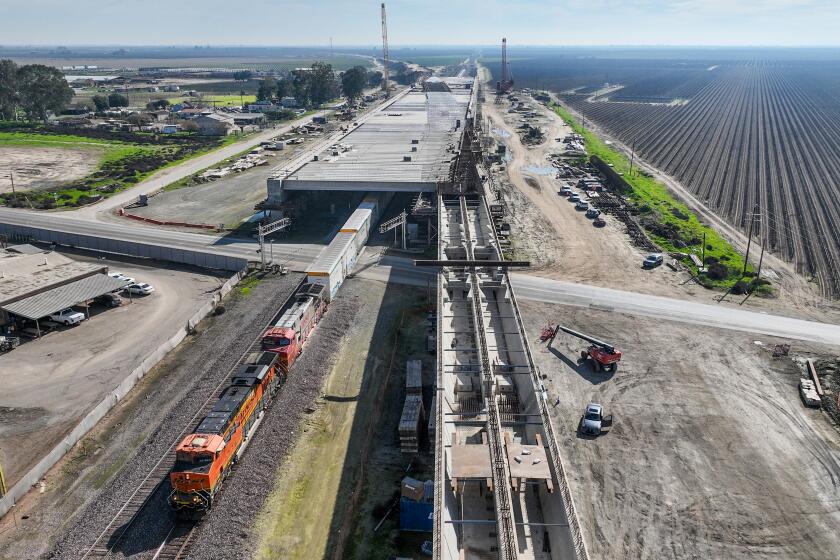Ruling Hasn’t Made Airport Uproar Any Quieter : Aviation: Even after court decision gives city power to control noise, residents call for even stricter regulations. But court sends signal that further restrictions may not be accepted.
- Share via
One week after the city won the power to control noise at Long Beach Municipal Airport, City Hall is treading cautiously to quell the roar at the nation’s third-largest general aviation airport.
And with good reason. The ink has scarcely dried on the federal appeals court ruling and, already, nearby residents are calling for even stricter noise regulations than those already on the books. The airlines are threatening to sue again if the volume is turned down another notch. And the city is eager to end, once and for all, an 8-year-old noise lawsuit that has already cost taxpayers roughly $1 million.
“We have to be careful that we don’t ruin what we have won. We don’t want to lose the ground we’ve gained,” Mayor Ernie Kell said nervously after a closed-door meeting with lawyers this week. “I really shouldn’t talk about it.”
The U.S. 9th District Court of Appeals handed Long Beach a big victory Oct. 24 when it found that the city had the authority to regulate the noise level at its 63-year-old airport. But the court also sent the city a signal that it had pushed the noise restrictions about as far as the court would allow.
That message may be lost on airport activists who live near the thundering runways, some of whom have never been satisfied with the noise ordinance that holds the number of daily commercial jet flights to 32 and the airport’s cumulative noise level to 65 decibels a day.
Some homeowners would like to see even fewer flights. Some are calling for a Sunday ban of the so-called “touch-and-go” takeoffs and landings executed by pilots in training.
“There’s an election not too far off,” Gene Tenhoff of the Aviation Noise Abatement Committee, a coalition of homeowners and aircraft users attempting to work out a compromise, said ominously. He said residents are prepared to write letters and lobby council members to write a new ordinance that residents can live with.
Airport-area residents are eagerly awaiting the city’s next move in the fight that began a decade ago when Long Beach first put a cap on noise at the airport, and 10 airlines subsequently filed suit. But city officials said they are in somewhat of a holding pattern evaluating a strategy that could prove politically or legally costly.
The court’s decision is not considered final for 21 days, and the airlines have the option of asking for a rehearing before the 9th District or requesting a review by the U.S. Supreme Court.
Meanwhile, legal experts say it appears that the city has little leeway to make the airport any quieter. The recently passed Airport Noise and Capacity Act of 1990, which set federal limits on airport noise, grandfathered in Long Beach’s stringent rules. To go beyond the city’s existing limits might be considered a violation of the congressional act, experts said.
In addition, the appellate court wrote that Long Beach’s current restrictions “appeared at first blush to be arbitrary or irrational” but were probably justified upon closer inspection.
“I think that’s a hint that anything more restrictive would be very risky,” said Los Angeles attorney Lee Blackman, special counsel to the city in the airport litigation. “The courts are upholding reasonable limits . . . but this is fragile.”
Activist residents who live in the historic and sometimes expensive homes under the flight paths say they are not interested in crippling the airport, just finding a place where planes and people can peacefully coexist.
Because of airline financial troubles, the number of commercial jets that take off daily is now at 27--five below the city’s cap. Complaints about noise appear to be running lower this year, airport officials said.
But a rebound in the aviation market could send the flight numbers soaring again.
“We don’t want to shut the airport down. The airport should have the opportunity to grow,” said Tenhoff, who lives just blocks from a major runway. “(But) we’ve got people in Signal Hill who are just getting killed by the helicopter noise.”
While the flight limits were placed on commercial passenger airliners--considered the noisiest--those jets make up only 7% of some half a million takeoffs and landings at the airport annually, airport Manager Chris Kunze said.
The majority of traffic comes from general aviation flights--the smaller cargo carriers, business planes and recreational aircraft that some residents complain make a loud and irritating buzz as they fly low over the city.
Small planes are regularly cited for violating noise rules, which pilots say are already too strict.
“Some of the smallest, least noisy airplanes are getting cited,” said Don Hart, president of the Long Beach Airport Assn. of pilots and airport-related businesses. “If a little guy like that gets a violation, does that seem fair?”
More to Read
Sign up for Essential California
The most important California stories and recommendations in your inbox every morning.
You may occasionally receive promotional content from the Los Angeles Times.










